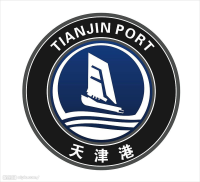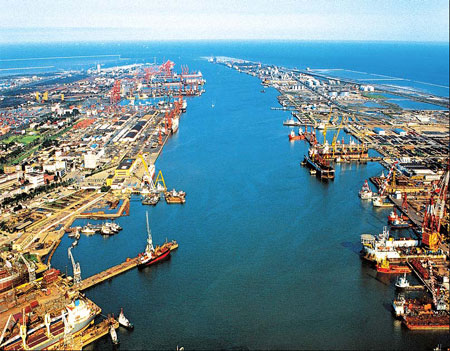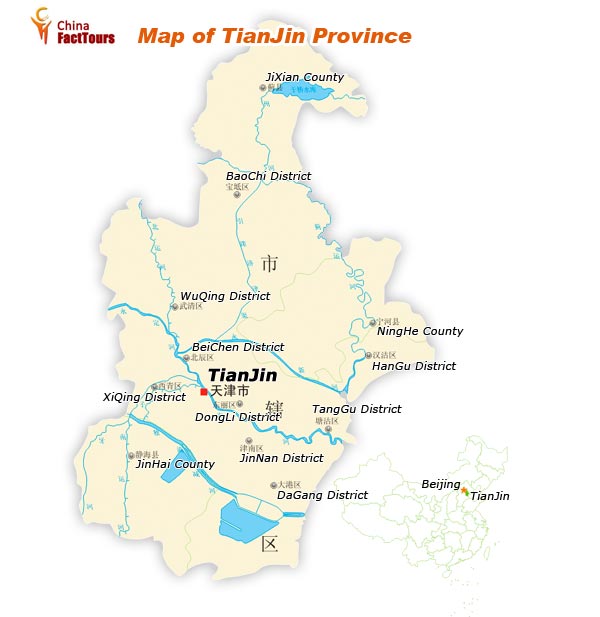The Port of Tianjin lies at the head of the Hai River about 26 nautical miles inland from the Bohai Gulf off the Yellow Sea on China's east coast. About 160 kilometers southeast of Beijing, the Port of Tianjin is 225 nautical miles west across the Bohai Gulf from the Port of Dalian. It is also connected to the Yangtze River by the Grand Canal. As the commercial gateway to Beijing and a maritime center, the Port of Tianjin is a ethnically diverse and cosmopolitan city. In 2005, the Tianjin municipality was estimated to hold over 10.2 million people, making it the sixth largest city in the People's Republic of China.
The Port of Tianjin's manufacturing sector is the biggest and fastest-growing part of the city's economy. The Tianjin municipality is about 40% farmland, and rice, wheat, and maize are its most important crops. Fishing is also important to the local economy. The Port of Tianjin also has an important industrial sector dominated by petrochemical industries, car manufacturers, textiles, metalworking, and mechanical industries. The municipality has reserves of about one billion tons of petroleum. Salt and geothermal energy are also important natural resources, and it had the countries first discovered deposits of manganese and boron.
The Port of Tianjin Authority operates the port. The Tianjin Port (Group) Company, Limited (Chinese) is the main operator in the Port of Tianjin, and it employees 20 thousand people. The Port of Tianjin is China's biggest artificial harbor and an important port for foreign trade. The access channel for the Port of Tianjin is 44 kilometers long and can accommodate ships up to 250-thousand tons (at low tide) with maximum draft of 19.5 meters. The Port of Tianjin's shoreline stretches for 21.5 kilometers.
The Port of Tianjin serves a vast hinterland that includes Beijing as well as the central and western areas of 14 provinces, municipalities, and autonomous regions that cover almost five million square kilometers and over half of the country. The Port of Tianjin has trade relationships with over 600 ports in 180 countries and regions around the world.
The Port of Tianjin contains more than 140 berths and the capacity to handle more than 289 million tons of cargo and over 9 million TEUs of containerized cargo per year.
One of the major cargoes handled and stored in the Port of Tianjin is coal. Seven specialized berths in the Port of Tianjin are devoted to handling coal exports and imports. The Port of Tianjin's Coal Terminal has capacity for 89 million tons of coal throughputs per year.
The Port of Tianjin's Container Yard covers over 350 hectares and can store 8.3 million tons of containerized cargo at one time. The Port of Tianjin Coal Terminal Company has a yard of 300 thousand square meters with capacity to store more than 1.7 million tons. The Port of Tianjin contains a total of 280 hectares of yards for bulk cargoes, and it can store up to 5.1 million tons of bulk at one time. The Port of Tianjin Shenhua Terminal Company offers 430 thousand square meters of yards with capacity for one-time storage of over 1.4 million tons of cargo.
The Tianjin municipal government, in partnership with the Port of Tianjin, has undertaken efforts to speed port development, improve port functions, and develop new facilities. These efforts include the construction of a new logistics center in southern Xinjiang, a new bulk container logistics center, and several smaller goods distribution centers to expand the Tianjin International Trade and Shipping Service Center and give port customers one-stop shipping services. During the five-year planning period from 2006 to 2010, the Port of Tianjin will invest 45 billion yuan to expand the port and improve port services.
The first phase of the new developments seeks to increase the Port of Tianjin's handling capacity. The Port of Tianjin will build 300-thousand ton crude oil terminals, and add specialized ore terminals and a second coal terminal. It will also expand the grocery terminal and finish work on the international cruise terminal by 2010. The goal is to achieve capacity for 400 million tons of cargo and handling capacity for containers to 10 million TEUs.
The second phase will be public infrastructure projects designed to modernize and expand Port of Tianjin functions. Projects include construction of a new deep-water channel, widening of the existing channel, addition of breakwaters, and other projects that will improve port operations.
The third phase for improvements to the Port of Tianjin involves construction of logistics centers that will improve port functions. Projects will include a logistics center in southern Xinjiang and a northern bulk container logistics center. The Port of Tianjin will emphasize improvements and expansions of the inland waterways and trade and development of more efficient international logistics and transit operations, particularly those with West Asia regions.
The fourth development phase will involve expansion of space by 30 square kilometers for future development of the Port of Tianjin. A new logistics processing zone will be established, and support services and development areas will be integrated to support the further development of international distribution, transit, procurement, and processing services.
By 2010, the Port of Tianjin will have capacity to handle more than 400 million tons of cargo and 10 million TEUs of containerized cargo. It will feature state-of-the-art facilities that incorporate the latest technologies and management practices to assure efficient, environmentally-friendly operations and world-class services.
The top ten priority projects that are currently underway in the Port of Tianjin include:
Construction of a second 300-thousand ton crude oil terminal in the southern border area that can accommodate 440-thousand ton tankers at a 484-meter long pier.
Construction of a specialized ore terminal with 440-meter-long berths that can accommodate 300-thousand-ton bulk carriers and can handle 23 million tons of cargo per year.
Completion of Phase 2 of the Shenhua Tianjin Coal Terminal to include 900 meters of quays with 100-thousand-, 70-thousand-, and 50-thousand-ton berths that can handle 35 million tons of coal per year.
Addition of three new container berths at the Beigang Container Terminal, adding 1100 meters alongside depth of 15.5 meters to the piers and capacity for annual throughput of 1.7 million TEUs.
Completion of additional facilities at the Port of Tianjin's Beigang Grocery Terminal at the eastern basin including four large berths with a total length of 1.1 thousand meters and capacity to handle 11 million tons of cargo per year.
Expansion of the Port of Tianjin International Cruise Terminal by adding two large cruise berths and 58 thousand square meters of space to the terminal to accommodate an additional 500 thousand passengers per year.
Increase infrastructure in the eastern Xinjiang area by adding 31.9 square kilometers of fill, 120 kilometers of roads, and necessary utilities to support the new port area.
Complete the channel widening project by increasing the width of the main channel to form an effective deep-water route to the Port of Tianjin, expand the width of existing navigable waterways within the Port of Tianjin, adding a new waterway to accommodate 250-thousand-ton oil tankers and 100-thousand-ton container ships, and expanding the channels on either side of the mouth of the main channel.
Improving connections feeding the Newport Center North Container Station yards.
Constructing a new 174.7 thousand square meter office building in the eastern Xinjiang area.
The port is part of the Binhai New Area district of Tianjin Municipality, the main special economic zone of Northern China, and it lies directly east of the Tianjin Economic-Technological Development Area. The Port of Tianjin is at the core of the ambitious development program of the Binhai New Area, and due to this developmental storm, change occurs at a very accelerated pace. The name "Tianjin Xingang"(literally "Tianjin New Port"), which strictly speaking refers only to the main seaport area, is sometimes used to refer to the whole port.



No comments:
Post a Comment